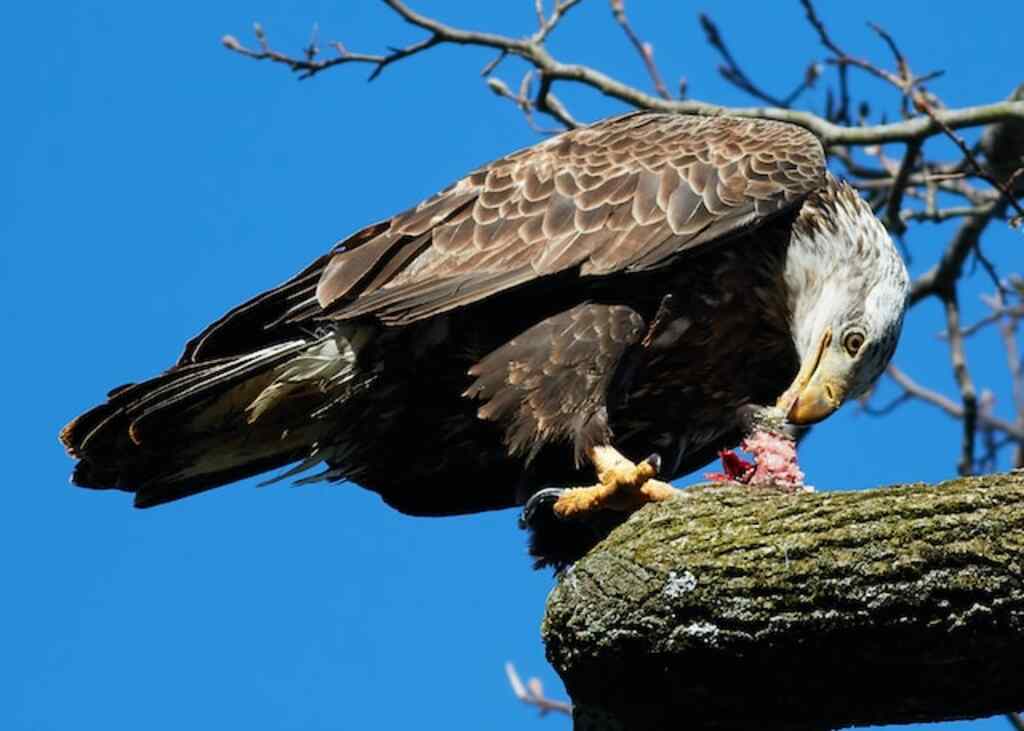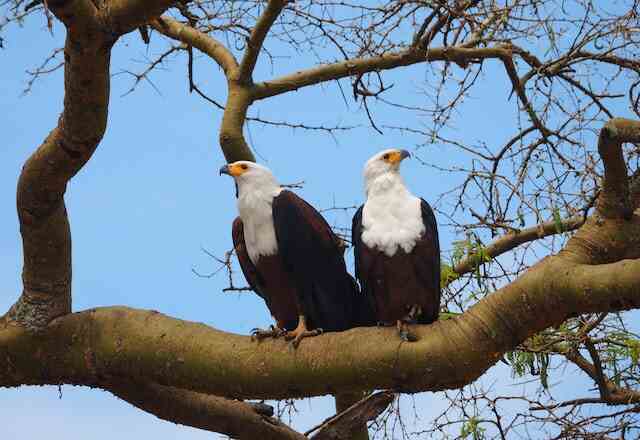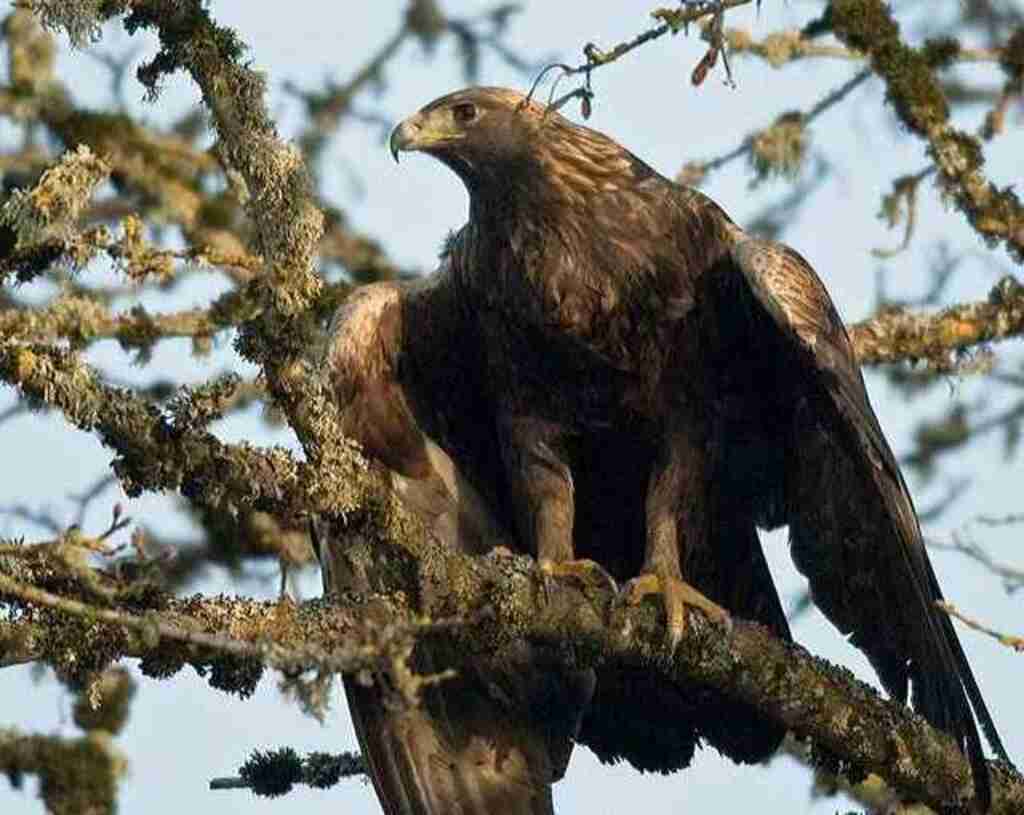Unravel the mysteries of eagles in this captivating article. Do eagles eat other eagles? Explore the paradox of intraspecific predation, where these majestic birds challenge the natural order.
Delve into their intricate interactions, implications on population dynamics, and ongoing conservation efforts. Discover the hidden secrets within the realm of eagles.
Table of Contents
- 1 Key Takeaways
- 2 Do Eagles Eat Other Eagles
- 3 Understanding Intraspecific Predation
- 4 Examining Eagle Species that Prey on Their Own
- 5 Factors that Influence Intraspecific Predation
- 6 The Implications on Eagle Populations
- 7 Observations and Case Studies
- 8 Behavioral and Ecological Explanations
- 9 Intraspecific Predation among Juvenile Eagles
- 10 Intraspecific Predation versus Interspecific Predation
- 11 Research and Conservation Efforts
- 12 Cultural and Symbolic Perspectives
- 13 Conclusion: A Complex Behavior in the World of Eagles
- 14 Frequently Asked Questions
- 14.1 Are all eagle species known to engage in intraspecific predation?
- 14.2 What are some factors that may contribute to an increase in intraspecific predation among eagle populations?
- 14.3 How do researchers study and observe intraspecific predation among juvenile eagles?
- 14.4 Is intraspecific predation more common among eagles than interspecific predation?
- 14.5 What are some conservation efforts being made to protect eagle populations affected by intraspecific predation?
- 15 Author
Key Takeaways
- Intraspecific predation challenges our preconceived notions about the natural order of things.
- Factors influencing intraspecific predation include competition for resources, territory defense, and breeding season dynamics.
- Eagles may prey on weaker individuals as potential competitors for resources.
- Intraspecific aggression plays a crucial role in eagle population dynamics and can lead to injury or death, reducing population size.

Do Eagles Eat Other Eagles
Yes, eagles have been known to exhibit intraspecific predation, where they prey on their own kind. This behavior can occur due to territorial disputes, competition for resources, or parental conflict.
Intraspecific predation among eagles challenges our understanding of the natural order and highlights the complexities of their interactions within populations.
Understanding Intraspecific Predation
Intraspecific predation is a phenomenon observed in some eagle species, where individuals of the same species engage in cannibalistic behavior, resulting in the imagery of powerful birds of prey feasting on their own kind.
This behavior is most commonly seen during times of scarcity when food resources are limited.
It may also occur due to territorial disputes or breeding behavior, where dominant eagles kill and consume weaker individuals.
Intraspecific predation plays a crucial role in population dynamics, as it helps regulate the population size and keeps it in balance with available resources.
Understanding the factors that drive intraspecific predation can provide valuable insights into the ecology and behavior of these magnificent birds.
Examining eagle species that prey on their own further explores the intricacies of this behavior and its implications for their survival and reproduction.
Examining Eagle Species that Prey on Their Own
Among the various predatory behaviors observed in eagle species, the phenomenon of certain eagles preying on their own kind is a topic that elicits a strong emotional reaction.
This behavior, known as intraspecific predation, challenges our perception of eagles as majestic and noble creatures.
It reminds us that even the most powerful and awe-inspiring animals are not exempt from the harsh realities of nature.
The fact that some eagle species engage in cannibalistic behavior raises questions about the complexities of their social structure and the dynamics of their populations.
It highlights the intense intraspecific competition that exists within eagle communities, where individuals must compete for limited resources and breeding territories.
Understanding the factors that influence intraspecific predation is essential for comprehending the intricate web of relationships that shape eagle populations.
Transitioning into the subsequent section about ‘factors that influence intraspecific predation’, it is crucial to explore the various elements that contribute to this phenomenon.

Factors that Influence Intraspecific Predation
Intraspecific predation, or the act of one eagle preying on another eagle, can be influenced by several key factors.
One factor is competition for resources, as eagles may resort to attacking and consuming their own kind when food sources are scarce.
Another factor is territory defense, where eagles may engage in aggressive behaviors to protect their established territories, leading to intraspecific predation.
Additionally, breeding season dynamics may play a role, as eagles may engage in aggressive interactions to establish dominance and secure mates, potentially resulting in intraspecific predation.
Competition for Resources
Interestingly, the majestic and noble eagles are not immune to the harsh reality of competition for resources within their own species. This competition arises due to limited resources such as food, nesting sites, and mates.
Four key factors influence the intensity of competition among eagles:
- Population density: Higher population densities lead to increased competition as more individuals vie for the same resources.
- Resource availability: When resources are scarce, eagles are more likely to compete aggressively for them.
- Age and sex: Younger eagles and males often face more intense competition as they try to establish themselves and attract mates.
- Seasonality: Competition for resources may vary throughout the year, with heightened competition during breeding seasons when resources are critical for successful reproduction.
This intense competition for resources sets the stage for the subsequent section on territory defense, where eagles fiercely guard their limited resources from intruders.
Territory Defense
Territory defense is a crucial behavior exhibited by eagles as they fiercely protect their limited resources from potential intruders.
Eagles establish their territorial boundaries through various displays of aggression, such as aerial confrontations and vocalizations.
These territorial boundaries serve as a means of securing essential resources required for survival, including food and nesting sites.
Maintaining exclusive access to these resources is especially important during the breeding season, as eagles compete for mates and suitable nesting locations.
Breeding patterns are influenced by the availability of resources within a territory, with eagles typically selecting breeding partners and establishing nests within their own territory.
Understanding the dynamics of territory defense and breeding patterns is essential for studying the population ecology and conservation of eagles.
Transitioning to the subsequent section about ‘breeding season dynamics,’ it is important to explore how eagles navigate the challenges posed by the limited resources and territorial boundaries during this critical period.
Breeding Season Dynamics
During the breeding season, eagles face the challenge of navigating limited resources and territorial boundaries while striving to secure suitable nesting sites and breeding partners.
To understand the dynamics of the breeding season, several key factors come into play:
1) Breeding success: Eagles compete for limited resources such as food and nesting sites to ensure the survival and successful reproduction of their offspring.
2) Population dynamics: The number of eagles in a given area affects the availability of suitable partners and resources. Competition for mates and territories can be intense in areas with high eagle populations.
3) Territory defense: Eagles fiercely defend their territories against intruders, including other eagles. This behavior ensures that only the strongest individuals can secure breeding sites and increase their chances of successful reproduction.
4) Mate selection: Eagles engage in complex courtship rituals and displays to attract potential mates. Factors such as physical condition, age, and dominance play a role in mate selection.
Understanding these breeding season dynamics is crucial for assessing the implications on eagle populations.

The Implications on Eagle Populations
The implications on eagle populations can be better understood by examining the potential impact of eagles preying on each other.
Intraspecific aggression, which refers to the aggression between individuals of the same species, plays a crucial role in population dynamics.
When eagles engage in aggressive behavior towards each other, it can lead to injury or death, thus reducing the overall population size.
Furthermore, if eagles view other eagles as potential competitors for resources such as food and territory, they may actively target and prey on weaker individuals, which can further impact population numbers.
Observations and case studies have provided valuable insights into the occurrence and consequences of intraspecific aggression in eagle populations.
By studying these interactions, researchers can gain a better understanding of the factors influencing eagle populations and develop strategies for their conservation and management.
Observations and Case Studies
Observations and case studies provide a window into the intricate dynamics of eagle populations, shedding light on the complex interactions and consequences that manifest within their ranks.
These studies have revealed that the influence of environmental factors plays a crucial role in shaping the interactions between eagles and their prey.
For example, a study conducted in a coastal region found that the availability of prey species, such as fish and small mammals, directly impacted the abundance and distribution of eagles in the area.
Similarly, another study documented the decline of eagle populations in an area where deforestation had led to the loss of suitable nesting sites and reduced prey populations.
These findings highlight the delicate balance between eagles and their environment, emphasizing the impact of environmental changes on prey population dynamics.
Transitioning to the subsequent section, behavioral and ecological explanations further elucidate the factors driving eagle predation patterns.
Behavioral and Ecological Explanations
Behavioral and ecological explanations provide valuable insights into the factors that drive the predation patterns of eagles, shedding light on the intricate dynamics of their interactions with prey species and their environment.
It is widely recognized that the influence of climate plays a significant role in shaping the foraging behavior and hunting success of eagles.
Changes in temperature and weather conditions can affect prey availability, forcing eagles to adapt their feeding strategies accordingly.
Additionally, the impact of eagles on prey populations cannot be understated. By preying on certain species, eagles can help regulate their populations and maintain ecological balance.
Understanding these behavioral and ecological factors is crucial for comprehending the complex dynamics of eagle predation.
This knowledge sets the stage for exploring the next section on intraspecific predation among juvenile eagles, wherein a different aspect of eagles’ predatory behavior will be examined.

Intraspecific Predation among Juvenile Eagles
Intraspecific predation among juvenile eagles reveals the intricate dynamics of their interactions within their own species and highlights the importance of understanding the role of competition in shaping their predatory behavior.
Various factors can influence the occurrence of intraspecific predation, including population density, resource availability, and breeding season dynamics.
During the breeding season, competition for food and territory intensifies, leading to increased aggression and potential predation among juvenile eagles.
Research has shown that larger and stronger individuals are more likely to engage in predatory behavior, as they have a competitive advantage over their smaller counterparts.
Understanding these dynamics is crucial for conservation efforts and managing eagle populations.
Transitioning into the next section, the study of intraspecific predation among juvenile eagles provides insights into their predatory behavior and sets the stage for exploring the differences between intraspecific and interspecific predation.
Intraspecific Predation versus Interspecific Predation
Intraspecific predation refers to the act of individuals within the same species preying on one another.
Interspecific predation involves individuals from different species preying on each other.
These two forms of predation differ in terms of the dynamics and ecological consequences they generate.
Understanding the interactions between predators of the same species and those of different species is crucial for comprehending the complex dynamics of predator-prey relationships and their impact on ecosystems.
Contrasting Intraspecific and Interspecific Predation
Contrasting the predatory behavior between eagles of the same species and eagles of different species evokes a sense of awe and curiosity in the audience.
When it comes to intraspecific aggression, eagles of the same species are known to display aggressive behaviors towards each other, especially during the breeding season or when defending territories.
Intraspecific predation among eagles is relatively rare, as they primarily compete for limited prey resources rather than preying on each other.
In contrast, interspecific predation occurs when eagles of different species interact. Eagles are opportunistic predators and will prey on smaller or weaker species if the opportunity arises.
This can include smaller raptors, waterfowl, and even carrion.
However, interspecific predation is not limited to eagles; they can also face predation from other predator species such as larger raptors or mammals.
These interactions between eagles and other predator species play a crucial role in shaping their behavior and distribution.
Transitioning into the subsequent section about interactions with other predator species, eagles face a complex network of interactions that influence their survival and ecological role.
Interactions with Other Predator Species
Predator-prey dynamics play a pivotal role in the survival and ecological balance of eagles, as they interact with a diverse array of formidable foes.
In addition to hunting and feeding on smaller prey species, eagles also face interactions with other predator species.
These interactions can be both competitive and cooperative, depending on the circumstances.
Intraspecific aggression, or aggression between individuals of the same species, can occur when resources such as food or nesting sites are limited.
This aggression can affect population dynamics by influencing breeding success and territorial behavior.
Understanding the dynamics of these interactions is crucial for effective research and conservation efforts aimed at protecting eagle populations.
By studying the interactions between eagles and other predators, researchers can gain insights into the ecological factors that shape eagle populations and inform conservation strategies.

Research and Conservation Efforts
Studying and monitoring intraspecific predation is crucial for understanding the dynamics and impacts of this phenomenon within a species.
By conducting thorough research, scientists can gain insights into the factors that contribute to intraspecific predation, such as competition for resources or territorial disputes.
Additionally, implementing conservation measures based on these findings can help mitigate the negative effects of intraspecific predation and promote the long-term survival of the species in question.
Studying and Monitoring Intraspecific Predation
To gain a comprehensive understanding of intraspecific predation, it is important to investigate the dietary habits of eagles, including the possibility of eagles preying on their own species.
Intraspecific aggression and population dynamics play a significant role in shaping eagles’ feeding behavior.
Studying and monitoring instances of eagles preying on other eagles can provide valuable insights into the ecological dynamics within eagle populations.
| Frequency and Circumstances of Intraspecific Predation Events |
| Predation Event | Frequency | Circumstances |
|---|---|---|
| Adult on Subadult | Rare | Territory disputes, dominance assertion |
| Adult on Juvenile | Occasional | Competition for resources, parental conflict |
| Juvenile on Juvenile | Rare | Limited food availability, aggression |
| Juvenile on Nestling | Infrequent | Sibling rivalry, scarcity of prey |
Analyzing the frequency and circumstances of intraspecific predation events provides valuable insights into the prevalence and patterns of this behavior among eagles.
These events may occur during territorial disputes, competition for resources, parental conflict, limited food availability, or sibling rivalry.
By understanding these factors, researchers can implement effective conservation measures to maintain healthy and sustainable eagle populations.
By analyzing the data, researchers can identify potential factors contributing to such behavior, such as competition for resources or territorial disputes.
Understanding intraspecific predation among eagles is crucial for implementing effective conservation measures to maintain healthy and sustainable eagle populations.
Implementing Conservation Measures
Implementing effective conservation measures is crucial for ensuring the long-term survival and ecological stability of eagle populations.
To achieve this, various conservation strategies are employed, which focus on understanding and managing population dynamics. These strategies include:
- Habitat preservation: Protecting and conserving the natural habitats of eagles is vital for their survival. This involves preserving nesting sites, foraging areas, and migration routes.
- Reducing human disturbance: Minimizing human activities that may disrupt eagle populations, such as habitat destruction, pollution, and disturbance near nesting sites.
- Promoting sustainable practices: Encouraging practices that prioritize the conservation of eagle habitats, such as sustainable logging, fishing, and agriculture.
- Monitoring and research: Regular monitoring of eagle populations and conducting scientific research to better understand their needs, population trends, and potential threats.
By implementing these conservation measures, we can ensure the continued existence of eagles and maintain the delicate balance of ecosystems they inhabit.
Transitioning into the subsequent section about ‘cultural and symbolic perspectives,’ these conservation efforts not only contribute to the ecological well-being but also recognize the cultural and symbolic importance of eagles in many societies.

Cultural and Symbolic Perspectives
Cultural and symbolic perspectives shed light on the interactions between eagles, revealing that the consumption of other eagles is not a common behavior within their social structure.
Eagles hold cultural significance in many societies, often representing strength, power, and freedom. In various spiritual beliefs, eagles are seen as sacred creatures, associated with divinity and higher powers.
These cultural and symbolic representations contribute to the perception of eagles as majestic and noble animals.
Consequently, the idea of eagles preying on their own kind contradicts these cultural and spiritual beliefs.
While eagles are known for their predatory nature, their diet primarily consists of small mammals, fish, and birds, rather than their own species.
This behavior aligns with the general understanding of eagles as powerful hunters, but not as cannibalistic creatures.
In conclusion, the consumption of other eagles remains a complex behavior in the world of eagles.
Conclusion: A Complex Behavior in the World of Eagles
In the previous subtopic, we explored the cultural and symbolic perspectives surrounding the topic of eagles preying on other eagles. Now, let us delve into the conclusion of this complex behavior in the world of eagles.
Juvenile eagles have been observed engaging in interspecific predation, where they occasionally prey on other birds, including other eagles. This behavior is believed to be a result of competition for resources and territorial disputes.
However, it is important to note that such incidents are relatively rare and do not represent the typical feeding habits of adult eagles.
While adult eagles primarily feed on fish, small mammals, and carrion, the occasional predation of other eagles by juveniles highlights the complexities of their social dynamics and the challenges they face as they transition to independence.
Understanding the intricacies of interspecific predation in eagles contributes to our knowledge of their ecological role in the natural world.

Frequently Asked Questions
Are all eagle species known to engage in intraspecific predation?
Intraspecific predation, the act of one eagle consuming another eagle of the same species, is not a common behavior observed among all eagle species. However, eagle social behavior, territoriality, and competition are important factors that can influence interactions between individuals.
What are some factors that may contribute to an increase in intraspecific predation among eagle populations?
Factors contributing to an increase in intraspecific predation among eagle populations may include competition for resources, territorial disputes, population density, and scarcity of prey. These factors can lead to aggression and cannibalism within eagle communities.
How do researchers study and observe intraspecific predation among juvenile eagles?
Researchers employ various techniques to study intraspecific predation among juvenile eagles, including direct observation, GPS tracking, and the use of remote cameras. These methods allow for the identification of behavioral patterns and provide valuable insights into this phenomenon.
Is intraspecific predation more common among eagles than interspecific predation?
Intraspecific predation, or predation between individuals of the same species, may have ecological implications for eagle population dynamics. It is unclear whether intraspecific predation is more common among eagles than interspecific predation.
What are some conservation efforts being made to protect eagle populations affected by intraspecific predation?
Conservation strategies to protect eagle populations affected by intraspecific predation include habitat preservation, implementing measures to reduce human disturbance, promoting genetic diversity through translocation programs, and monitoring prey availability to ensure adequate food resources for eagles. These efforts aim to mitigate the impact on eagle populations and promote their long-term survival.



